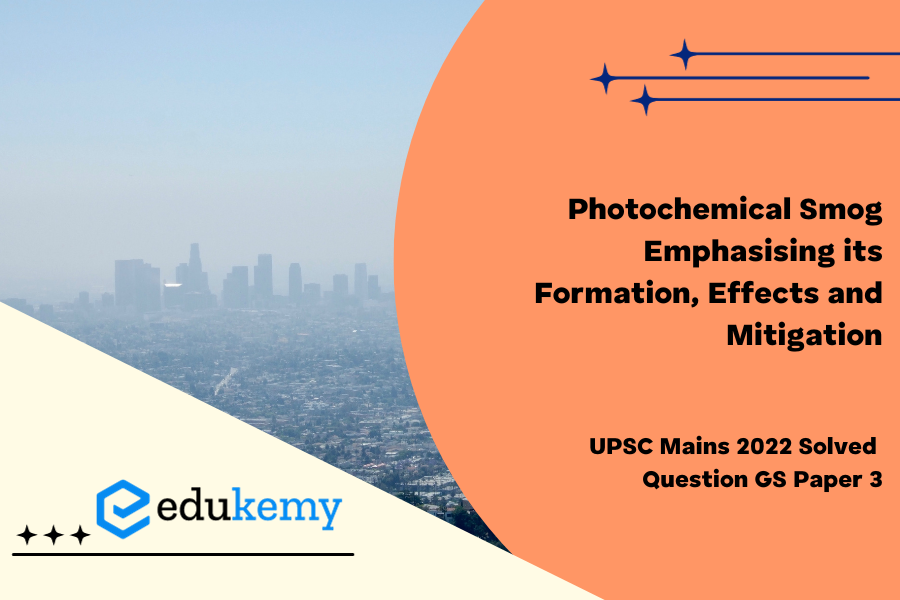Photochemical smog forms from vehicular and industrial emissions reacting with sunlight, releasing pollutants like ozone and NOx. It leads to respiratory issues and environmental harm. Mitigation involves reducing emissions, promoting sustainable transportation, and enforcing strict regulations. The 1999 Gothenburg Protocol aims to control air pollutants, fostering international cooperation for cleaner air.
UPSC Mains General Studies Paper – 3 Mains 2022
UPSC Mains Civil Services IAS Exam Question Paper – 2022
Contents
Approach
- Introducing your answer the key words Photochemical Smog with current issue acknowledgment
- Mention the detail of formation , effects and mitigation of Photochemical smog.
- Mention the objective and key finding of 1999 Gothenburg Protocol.
- Accordingly conclude it.
Introduction
Photochemical smog is a type of air pollution that occurs in urban areas with high levels of vehicle emissions and industrial activities. It is characterised by a hazy, brownish-grey colour in the atmosphere. Photochemical smog forms when certain air pollutants, primarily nitrogen oxides (NOx) and volatile organic compounds (VOCs), react in the presence of sunlight.
Body

Formation of Photochemical Smog:
- Emissions: NOx and VOCs are released into the atmosphere from various sources, including vehicles, power plants, factories, and chemical solvents.
- Sunlight: Sunlight provides the energy required for the chemical reactions to occur.
- Chemical Reactions: In the presence of sunlight, NOx and VOCs undergo a series of complex reactions known as photochemical reactions. These reactions lead to the formation of ground-level ozone (O3) and other secondary pollutants.

Effects of Photochemical Smog:
- Respiratory Issues: Photochemical smog can cause respiratory problems such as coughing, wheezing, shortness of breath, and increased susceptibility to respiratory infections.
- Eye Irritation: Exposure to smog can irritate the eyes, leading to redness, itching, and tearing.
- Environmental Damage: Photochemical smog can harm plants and crops, leading to reduced agricultural yields. It can also damage buildings and monuments, causing corrosion and discoloration.
Mitigation of Photochemical Smog:
- Emission Reductions: Implementing strict emission standards for vehicles, power plants, and industrial facilities can significantly reduce the amount of NOx and VOCs released into the atmosphere.
- Vehicle Regulations: Encouraging the use of cleaner fuels, promoting public transportation, and adopting stricter vehicle emissions standards can help reduce smog-forming pollutants from transportation sources.
- Industrial Controls: Employing advanced pollution control technologies, such as catalytic converters and scrubbers, in industrial processes can minimize the release of NOx and VOCs.
- Urban Planning: Implementing smart urban planning strategies like improving public transportation networks, creating pedestrian-friendly infrastructure, and promoting green spaces can help reduce vehicle emissions and improve air quality.

The Gothenburg Protocol (1999):
The Gothenburg Protocol is an international agreement under the United Nations Economic Commission for Europe (UNECE) that aims to reduce transboundary air pollution, including the formation of photochemical smog. The protocol established emission reduction targets for several pollutants, including sulfur dioxide (SO2), nitrogen oxides (NOx), volatile organic compounds (VOCs), and ammonia (NH3).
Key elements of the Gothenburg Protocol include:
- National Emission Ceilings: The protocol sets national emission reduction targets for each participating country, which are legally binding.
- Sector-specific Measures: The protocol encourages countries to implement specific measures to reduce emissions from various sectors, including energy production, industry, transport, and agriculture.
- Flexibility Mechanisms: Countries can trade emission allowances with each other and use flexible mechanisms to achieve their reduction targets more cost-effectively.
- Review and Monitoring: The protocol establishes a reporting and review mechanism to monitor the progress of participating countries in meeting their emission reduction commitments.
Conclusion
The Gothenburg Protocol has played a significant role in reducing air pollution and improving air quality across Europe by setting targets and promoting concerted efforts among participating countries to mitigate the formation of photochemical smog and other pollutants.
Currently, the protocol is under negotiation for a revised protocol. It was updated in 2012 to include particulate matter and black carbon.
In case you still have your doubts, contact us on 8792740517.
For UPSC Prelims Resources, Click here
For Daily Updates and Study Material:
Join our Telegram Channel – Edukemy for IAS
- 1. Learn through Videos – here
- 2. Be Exam Ready by Practicing Daily MCQs – here
- 3. Daily Newsletter – Get all your Current Affairs Covered – here
- 4. Mains Answer Writing Practice – here


